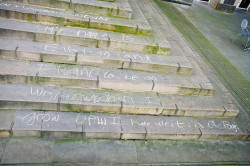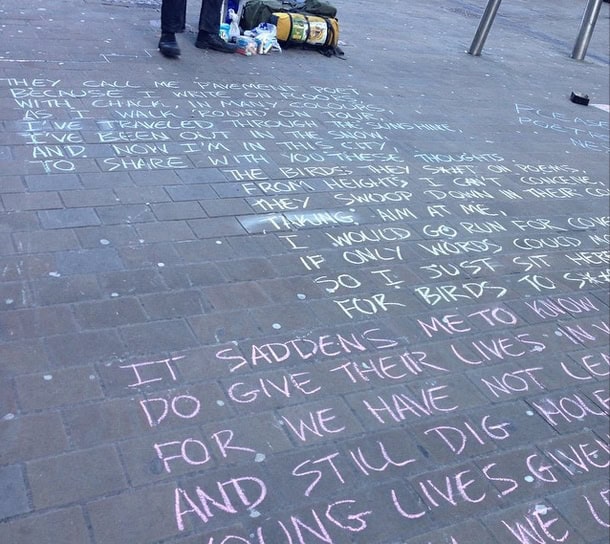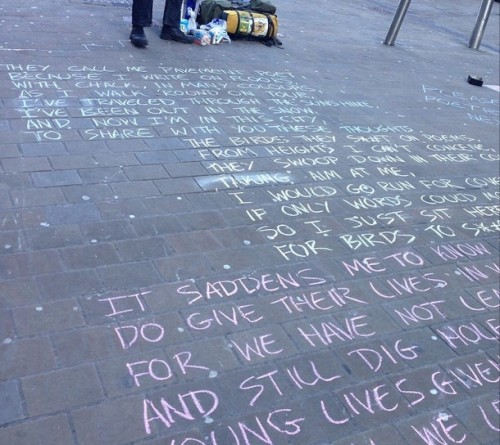Recently on my way to a city council convened workshop ‘Rethinking the city centre’ I took a few snaps along the way. More than anything to actively LOOK at the stuff we walk past without much thought.
By chance we came across The Pavement Poet who was busy writing a great big poem on Albion Street, Phil Kirby remarked upon the buskers playing nearby and even though I didn’t really pay much heed to the actual verse I did talk to a stranger about what he thought about it. He liked the poem, and we started talking about how he had moved to Leeds and what he loved about living here (friendly people!).
As somebody who is very interested in the public playfulness of Leeds I felt cheered that our city was encouraging light-touch street art, stuff which left no lasting or permanent damage and obviously created a talking point for people. The quality of the verse or even the aesthetic was not really that important to me. As Phil has reminded me, we chalked upon the steps of Leeds Museum (without permission) our hopes and dreams for a more playful Leeds back in 2012 after our event ‘Does Leeds Needs a City Playground?’ No harm came to the steps and we felt emboldened by the act of writing together.

I attended the workshop, saw some interesting images and heard some heartfelt provocations from different city stakeholders and actually felt that we’d come a long way in the 20 years since I’ve lived here. Again being invited is a privilege as I have no official status other than a desire to play my own small part in being creative and encouraging play in the city. At the event it didn’t go unremarked that the diversity of participation at such events needed consideration if we were to create a city centre that catered and welcomed all ages, cultures and genders. There were interesting discussions about the kind of city centre the people in that room felt we should be aiming for, not least from Chris Thompson from sustainable property developers Citu who suggested we should boldly follow in Helsinki’s footsteps and aspire to have a car free city centre by 2030.
Yet whilst we were imagining a bold new future from the comfort of Leeds Town Hall I learnt that the Pavement Poet had his poem washed away by Leeds City Centre street cleaning team whilst he was creating it, and it led to the conversation below on Twitter. Here’s the video of what happened.
I would be really interested in your views. Is Leeds signed up to a ‘business charter’ as stated by the Pavement Poet? If so what does this involve? Do you feel that permission should be sought before creating public chalk art? In times of declining public funding is it a good use of money to clean such freedom of expression away? Is one person’s prose another’s poison?
What kind of city centre do you want?
Do have a chat with me in the comments on on twitter @emmambearman


It’s petty and kinda what you’d expect from an out of touch Government body. They did exactly the same when the TDF came to Leeds; all the excitement and inspiration that thousands of kids (and adults) were injected with by such a huge event and seeing such world class athletes, not to mention one of the biggest party atmospheres I’ve known in Leeds, was embodied in myriad chalk drawings, full of joy on our roads and pathways only to be washed away all too early. Not by the typical Yorkshire rain you might expect, but by embarrassed dayglo jacketed officials under the order of a don’t-quite-get-it-yet Council. As long as this attitude persists amongst people in official office, we’ll never even be seen in the same creative league as the likes of Manchester and Liverpool.
If I were keen to have my lyrical ballads, sonnets and odes (let’s call them doggerel) broadcast to a wider audience, I think I’d be inclined to stand on the pavement and read my oeuvre out loud – thus ensuring the iambs and trochees, the caesurae and enjambements, the onomatopoeiae and assonances and all the rest of the poetic apparatus were emphasised and transmitted accurately.
Buskers, graffiti, public art? Some (not all) of them are aural and visual pollution but are they any worse than car exhaust or Bridgewater Place? We tolerate (have to tolerate) car parks and excrescences like the Westfield Centre so can’t really see the problem with some chalk on a pavement (unless it’s hampering ingress to a palace of craft ales and artisan cheeses).
Does this charter cover ‘cleaning’ art where you use a jet washer and a stencil? That leaves a mark but is effectively cleaning? What about kids hopscotch drawings? Where does it begin and end?
What would happen in Leeds if a Banksy original appeared on the side of a building one day?
In Bristol the Council would let the people decide if it was to be removed or left in place. They’d photograph it, post the photos to their website and then the voting would begin.
http://www.theguardian.com/artanddesign/2009/aug/31/graffiti-art-bristol-public-vote
In London around the Brick Lane area Street Art is legal and there are in fact organised Street Art Tours in that area that you can pay go on. This attracts artists from all over the world knowing that their work will find an appreciative audience.
http://inspiringcity.com/2013/05/11/a-street-art-tour-of-brick-lane-in-london/
Back to Leeds and the Chalk Poet.
Well I think that if someone wants to start writing poems in chalk on a public street then they should be allowed to do so. But they have to recognise that they do not own that space and they also have to accept that if someone else decides to walk over their poems then they have every right to do so. After all the streets have a practical function and are fundamentally thoroughfares which we all have to share.
As for washing it off, well why bother? Why go to all that cost when the rain will do the job for us?
Good post – and all of this stuff about public space really interests me. However for now I’d like to pick up on your point about who attended the workshop that you mentioned. I very much accept that I won’t get invited to/couldn’t afford the time to attend all the different workshops and events that in a range of different ways explore what the future might look like for our city.
However I’m getting increasingly frustrated at how I usually find out about these meetings on the day that they’re happening (usually from a tweet from someone saying they’re going along) – and I very rarely find out afterwards about what is talked about. Perhaps this is progress (a few years ago I wouldn’t have know about them at all) but it doesn’t feel like a great way to engage your citizens in how our city is run.
I think more effort needs to be made to see events as part of a process, rather than as an end in themselves. If the Council/Gehl/Arup or whoever are running an event exploring the future of the South Bank (for example) why not use an event as a starting point for wider conversations? Invite someone with the specific remit to blog and tweet about what’s discussed. Clearly doing something like that adds a layer of complexity to what is no doubt an already complex process, but I’d be sure it’d result in some much more interesting conclusions. Many of us really care about where we live and, given the opportunity, are keen to find constructive ways to contribute. That opportunity to contribute shouldn’t begin and end with a workshop.
The alternative is that many of us continue to feel that decisions big and small about our city are taken by small groups of people who select who they’d like to attend their visioning workshops and the like. And guess what, men in suits end up inviting loads of men in suits!
And we all know how this stuff works – for many people (and the organisations they represent) their main focus, once they’re invited to sit at the top table, is to make sure that they stay there. So you often end up with pretty uninspiring groupthink, constrained by the politics of the possible, rather than a creative re-imagining of what our city could be.
I value the effort you put in on here to open up discussions more widely – and I think we really need to keep working at that – and challenging those with more power to think more creatively about how they involve people who care about their city.
Well somebody seems to be playing games, don’t they? The Business Charter wasn’t raised at a similar ‘re shaping the City Centre’ event before Christmas, which has me wondering what the purpose of these conversations are. If the focus for the city centre is purely business where do citizens fit in? What welcomes them in up if they’re not consumers, punters or have money to spend? I’m also intrigued by the constant demand for quality, whatever that means, for art, however temporary, in the City Centre, when no such demands are made of business. Zero hour contracts, minimum wage, gender gaps all welcome without challenge, often without even comment.
Coming from a southern coastal town where chalk is ubiquitous and because of human nature so is ‘chalking’ I find it incredulous that it is not just left to nature to do the job. Imagine in my old home town, it’d be a bit like washing away your bedrock and indeed your future.
I’ve seen a verse of the Pavement Poet before: I’ve also seen a wonderful exhortation to rise up and combat the increasing poverty and immiseration we see in Leeds (I think it was after a demo not so long ago).
A note on chalking specifically: it has increasingly been prosecuted as criminal damage – in fact there was a case when a student protestor at UCL was fined for chalking in support of a cleaners’ strike (Apparently it cost £1000s to clean the stone, which is somewhat questionable given the frequency of acidic London rain).
I would also echo Rob’s comments above about inclusivity and participation. Even as someone quite personally and professionally engaged in urban development and planning, I find it hard to know what’s going on in the city and how I can be involved. I also find the constant championing of ‘innovation’ and ‘creativity’ quite laughable in a local authority which clearly has no idea how to manage its public retail and amenity space
(see the erasure of Chinatown, the Leviathan private shopping space encroaching on the Market, the constant building of shops which remain empty) – and simply desperately imports unsuccessful models from elsewhere.
I also don’t understand clearly who orders chalking to be removed and why – perhaps someone could clarify. There can’t be a health and safety issue with it. It isn’t noisy so the anti-busking guidelines don’t apply…
When it comes to chalking, or reverse graffiti in Leeds, it’s not what you know… Leeds gave birth to reverse graffiti, and then drove him away.
Creative parable of Disruptive Culture in Leeds
Google: Paul Curtis Moose and then Google: Leeds Council reverse graffiti